Changes in Extremes Rainfall Events in Present and Future Climate Scenarios over the Teesta River Basin, India
Abstract
1. Introduction
2. Materials and Methods
2.1. Study Region
2.2. Data Sources
2.3. Generalized Extreme Value (GEV)
2.4. Precipitation Anomaly Indices
2.5. Extreme Precipitation Indices (EPI)
3. Results
3.1. Evaluation of Rainfall Variability in the TRB
3.2. Hydrological Extremes from GEV Distribution
3.3. Temporal Distribution and Future Variation of EPI
3.4. Evaluation of SPI and RAI
4. Discussion
5. Conclusions
Author Contributions
Funding
Institutional Review Board Statement
Informed Consent Statement
Data Availability Statement
Acknowledgments
Conflicts of Interest
Abbreviations
| TRB | Teesta River Basin |
| EPI | Extreme Precipitation Index |
| SPI | Standardized Precipitation Index |
| GEV | Generalized Extreme Value Distribution |
| CCCR | Centre for Climate Change Research |
| IITM | Indian Institute of Tropical Metrology |
| IMD | India Meteorological Department |
| SRTM | Shuttle Radar Topography Mission |
Appendix A
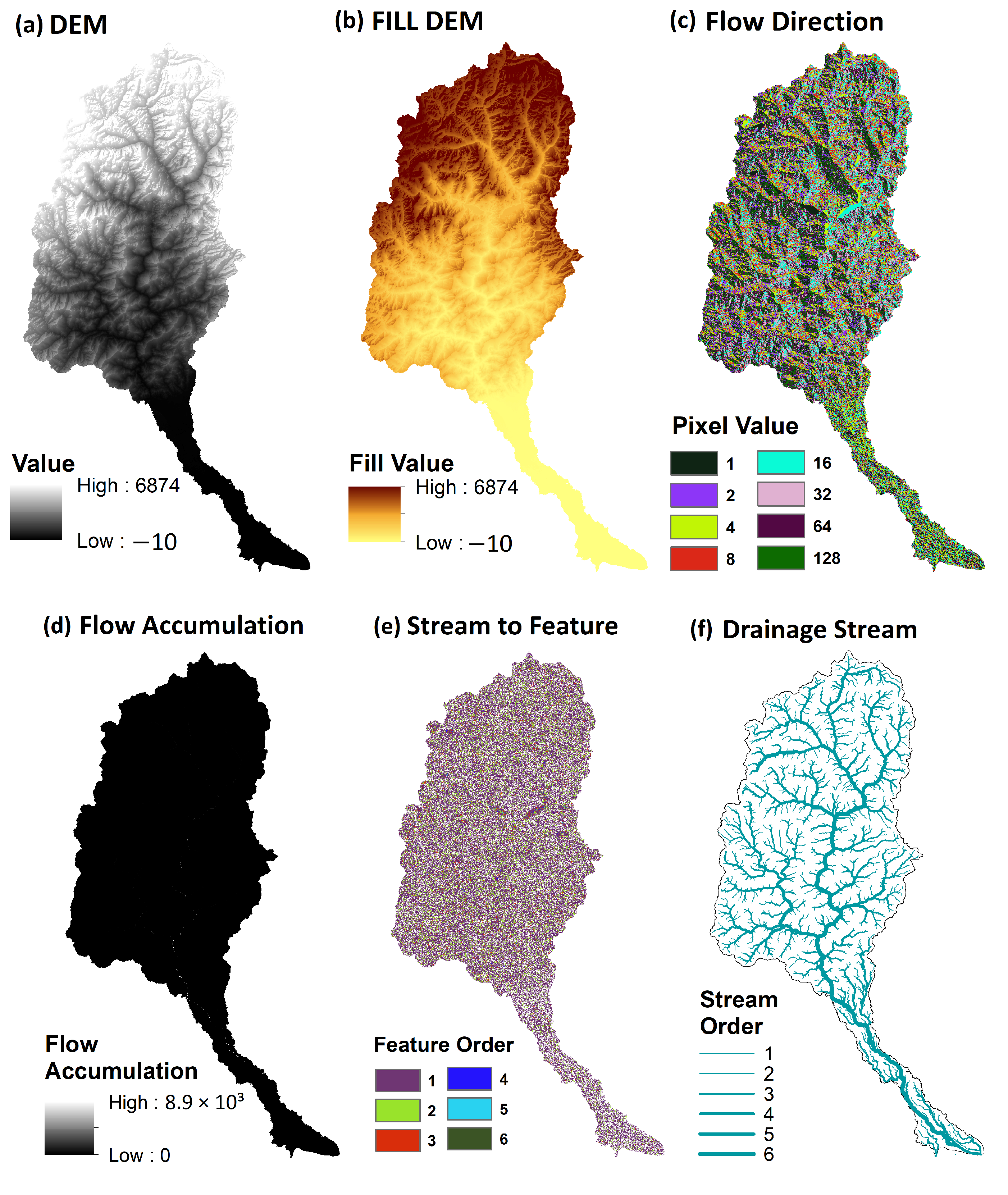
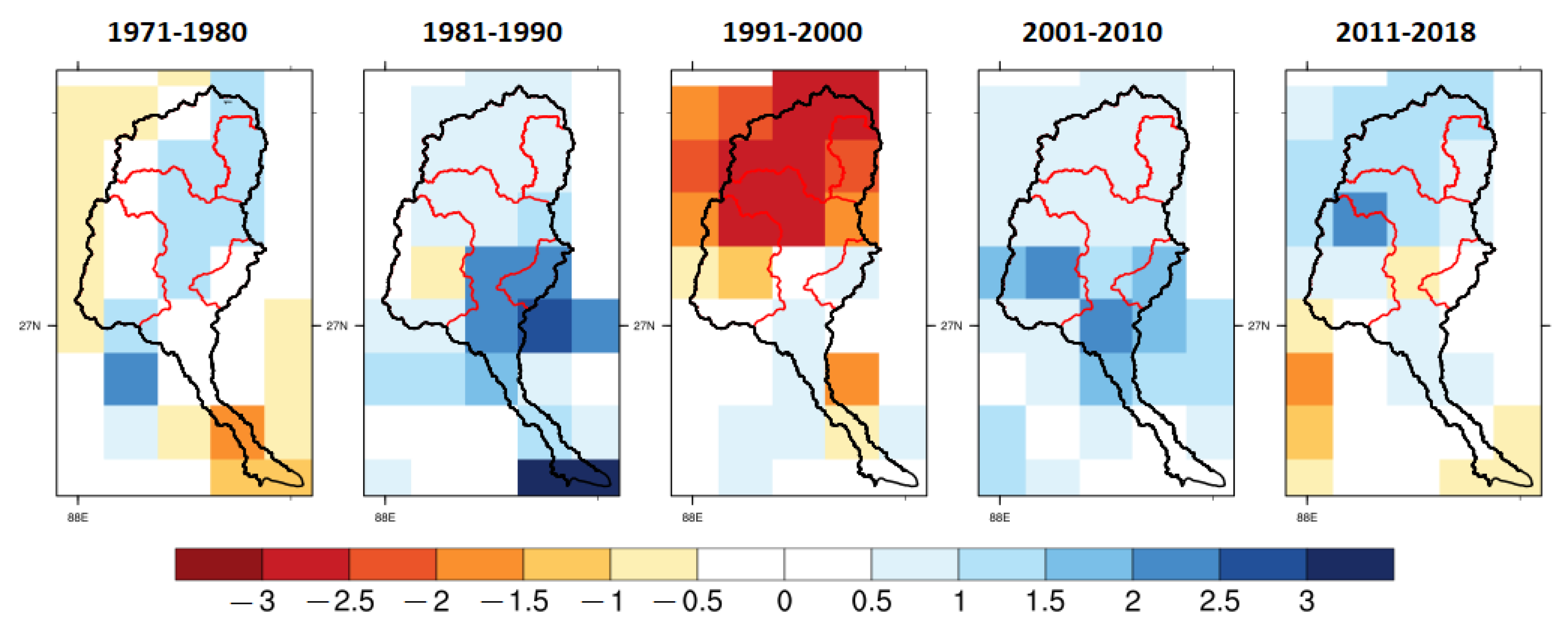
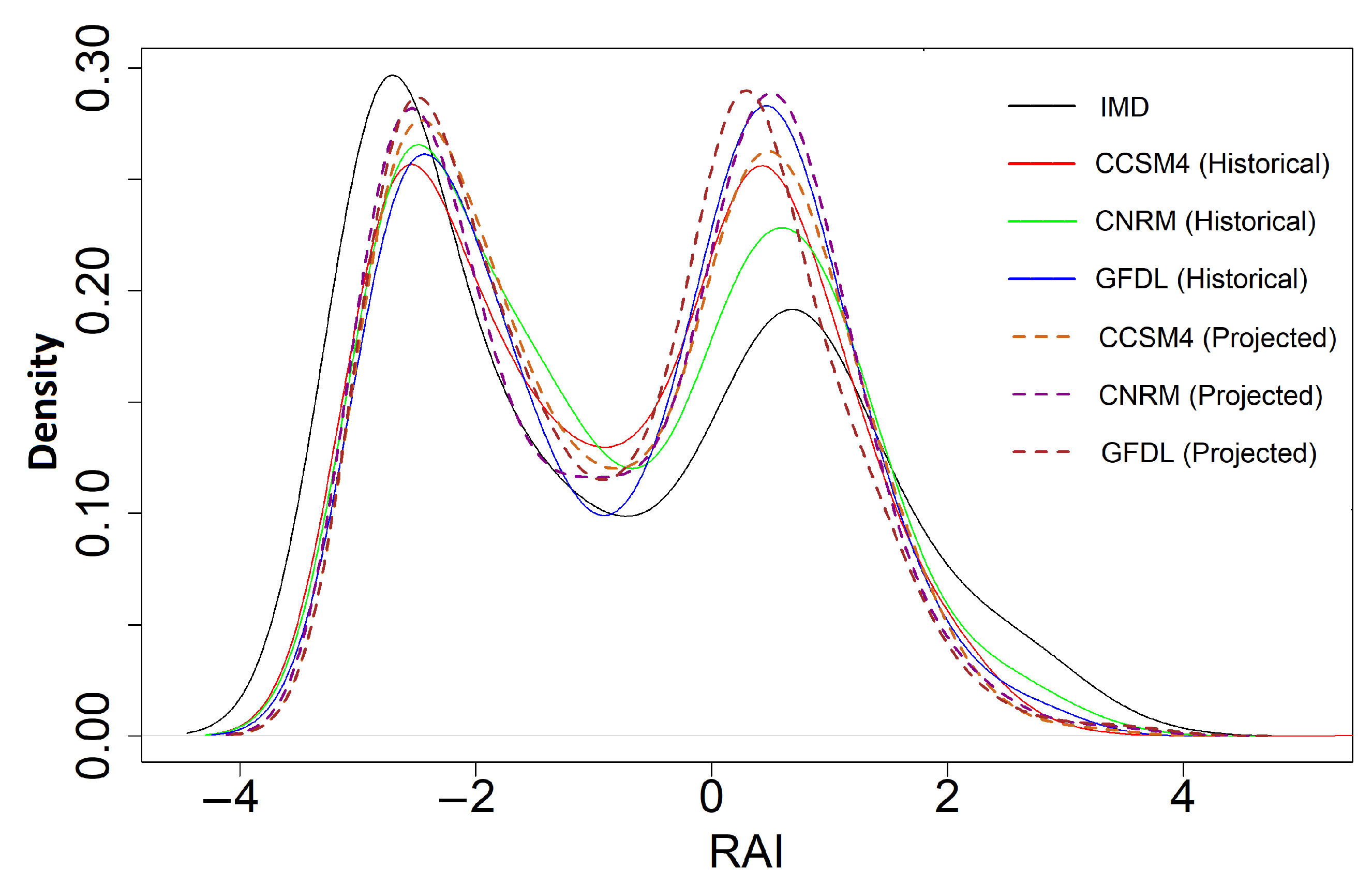
References
- Pratap, S.; Srivastava, P.K.; Routray, A.; Islam, T.; Mall, R.K. Appraisal of hydro-meteorological factors during extreme precipitation event: Case study of Kedarnath cloudburst, Uttarakhand, India. Nat. Hazards 2020, 100, 635–654. [Google Scholar] [CrossRef]
- Singh, R.; Mal, S. Trends and variability of monsoon and other rainfall seasons in Western Himalaya, India. Atmos. Sci. Lett. 2014, 15, 218–226. [Google Scholar] [CrossRef]
- Xu, J.; Badola, R.; Chettri, N.; Chaudhary, R.P.; Zomer, R.; Pokhrel, B.; Hussain, S.A.; Pradhan, S.; Pradhan, R. Sustaining biodiversity and ecosystem services in the Hindu Kush Himalaya. In The Hindu Kush Himalaya Assessment; Springer: Berlin/Heidelberg, Germany, 2019; pp. 127–165. [Google Scholar]
- Hengade, N.; Eldho, T.; Ghosh, S. Climate change impact assessment of a river basin using CMIP5 climate models and the VIC hydrological model. Hydrol. Sci. J. 2018, 63, 596–614. [Google Scholar] [CrossRef]
- Mall, R.K.; Gupta, A.; Singh, R.; Singh, R.S.; Rathore, L. Water resources and climate change: An Indian perspective. Curr. Sci. 2006, 90, 1610–1626. [Google Scholar]
- Rao, G.V.; Reddy, K.V.; Srinivasan, R.; Sridhar, V.; Umamahesh, N.; Pratap, D. Spatio-temporal analysis of rainfall extremes in the flood-prone Nagavali and Vamsadhara Basins in eastern India. Weather Clim. Extrem. 2020, 29, 100265. [Google Scholar]
- Yamazaki, D.; Watanabe, S.; Hirabayashi, Y. Global flood risk modeling and projections of climate change impacts. In Global Flood Hazard: Applications in Modeling, Mapping, and Forecasting; John Wiley & Sons, Inc.: New York, NY, USA, 2018; pp. 185–203. [Google Scholar]
- Zhang, Q.; Han, J.; Yang, Z. Spatiotemporal characteristics of regional precipitation events in the Jing-Jin-Ji region during 1989–2018. Int. J. Climatol. 2021, 41, 1190–1198. [Google Scholar] [CrossRef]
- Dimri, A.; Chevuturi, A.; Niyogi, D.; Thayyen, R.J.; Ray, K.; Tripathi, S.; Pandey, A.; Mohanty, U. Cloudbursts in Indian Himalayas: A review. Earth-Sci. Rev. 2017, 168, 1–23. [Google Scholar] [CrossRef]
- Mall, R.K.; Srivastava, R.K.; Banerjee, T.; Mishra, O.P.; Bhatt, D.; Sonkar, G. Disaster risk reduction including climate change adaptation over south Asia: Challenges and ways forward. Int. J. Disaster Risk Sci. 2019, 10, 14–27. [Google Scholar] [CrossRef]
- Mukherjee, S.; Aadhar, S.; Stone, D.; Mishra, V. Increase in extreme precipitation events under anthropogenic warming in India. Weather Clim. Extrem. 2018, 20, 45–53. [Google Scholar] [CrossRef]
- Nandargi, S.; Gaur, A.; Mulye, S. Hydrological analysis of extreme rainfall events and severe rainstorms over Uttarakhand, India. Hydrol. Sci. J. 2016, 61, 2145–2163. [Google Scholar] [CrossRef]
- Roxy, M.K.; Ghosh, S.; Pathak, A.; Athulya, R.; Mujumdar, M.; Murtugudde, R.; Terray, P.; Rajeevan, M. A threefold rise in widespread extreme rain events over central India. Nat. Commun. 2017, 8, 708. [Google Scholar] [CrossRef]
- Vellore, R.K.; Kaplan, M.L.; Krishnan, R.; Lewis, J.M.; Sabade, S.; Deshpande, N.; Singh, B.B.; Madhura, R.; Rama Rao, M. Monsoon-extratropical circulation interactions in Himalayan extreme rainfall. Clim. Dyn. 2016, 46, 3517–3546. [Google Scholar] [CrossRef]
- Arora, A.; Pandey, M.; Siddiqui, M.A.; Hong, H.; Mishra, V.N. Spatial flood susceptibility prediction in Middle Ganga Plain: Comparison of frequency ratio and Shannon’s entropy models. Geocarto Int. 2021, 36, 2085–2116. [Google Scholar] [CrossRef]
- Bharat, S.; Mishra, V. Runoff sensitivity of Indian sub-continental river basins. Sci. Total Environ. 2021, 766, 142642. [Google Scholar] [CrossRef] [PubMed]
- Chanapathi, T.; Thatikonda, S.; Raghavan, S. Analysis of rainfall extremes and water yield of Krishna river basin under future climate scenarios. J. Hydrol. Reg. Stud. 2018, 19, 287–306. [Google Scholar] [CrossRef]
- Nie, Y.; Pritchard, H.D.; Liu, Q.; Hennig, T.; Wang, W.; Wang, X.; Liu, S.; Nepal, S.; Samyn, D.; Hewitt, K.; et al. Glacial change and hydrological implications in the Himalaya and Karakoram. Nat. Rev. Earth Environ. 2021, 2, 91–106. [Google Scholar] [CrossRef]
- Pachauri, R.; Meyer, L. Climate Change 2014: Synthesis Report. Contribution of Working Groups I, II and III to the Fifth Assessment Report of the Intergovernmental Panel on Climate Change; IPCC: Geneva, Switzerland, 2014. [Google Scholar]
- Chaubey, P.K.; Mall, R.; Jaiswal, R.; Payra, S. Spatio-Temporal Changes in Extreme Rainfall Events Over Different Indian River Basins. Earth Space Sci. 2022, 9, e2021EA001930. [Google Scholar] [CrossRef]
- Mandal, S.P.; Chakrabarty, A. Flash flood risk assessment for upper Teesta river basin: Using the hydrological modeling system (HEC-HMS) software. Model. Earth Syst. Environ. 2016, 2, 1–10. [Google Scholar] [CrossRef]
- Starkel, L.; Wiejaczka, Ł.; Kiszka, K. Role of tributaries in shaping the middle course of the Himalayan River Teesta after the 1968 extreme floods. Curr. Sci. 2017, 112, 1896–1903. [Google Scholar] [CrossRef]
- Gemeda, D.O.; Korecha, D.; Garedew, W. Monitoring climate extremes using standardized evapotranspiration index and future projection of rainfall and temperature in the wettest parts of southwest Ethiopia. Environ. Challenges 2022, 7, 100517. [Google Scholar] [CrossRef]
- Fofana, M.; Adounkpe, J.; Larbi, I.; Hounkpe, J.; Koubodana, H.D.; Toure, A.; Bokar, H.; Dotse, S.Q.; Limantol, A.M. Urban flash flood and extreme rainfall events trend analysis in Bamako, Mali. Environ. Challenges 2022, 6, 100449. [Google Scholar] [CrossRef]
- Chaubey, P.K.; Kundu, A.; Mall, R. A geo-spatial inter-relationship with drainage morphometry, landscapes and NDVI in the context of climate change: A case study over the Varuna river basin (India). Spat. Inf. Res. 2019, 27, 627–641. [Google Scholar] [CrossRef]
- Chaubey, P.K.; Srivastava, P.K.; Gupta, A.; Mall, R. Integrated assessment of extreme events and hydrological responses of Indo-Nepal Gandak River Basin. Environ. Dev. Sustain. 2021, 23, 8643–8668. [Google Scholar] [CrossRef]
- Jain, A.O.; Thaker, T.P.; Misra, A.K.; Singh, A.K.; Kumari, P. Determination of sensitivity of drainage morphometry towards hydrological response interactions for various datasets. Environ. Dev. Sustain. 2021, 23, 1799–1822. [Google Scholar] [CrossRef]
- Pandey, V.; Srivastava, P.K.; Mall, R.; Munoz-Arriola, F.; Han, D. Multi-satellite precipitation products for meteorological drought assessment and forecasting in Central India. Geocarto Int. 2022, 37, 1899–1918. [Google Scholar] [CrossRef]
- Youssef, A.M.; Pradhan, B.; Hassan, A.M. Flash flood risk estimation along the St. Katherine road, southern Sinai, Egypt using GIS based morphometry and satellite imagery. Environ. Earth Sci. 2011, 62, 611–623. [Google Scholar] [CrossRef]
- Abdel-Fattah, M.; Saber, M.; Kantoush, S.A.; Khalil, M.F.; Sumi, T.; Sefelnasr, A.M. A hydrological and geomorphometric approach to understanding the generation of wadi flash floods. Water 2017, 9, 553. [Google Scholar] [CrossRef]
- Asfaw, D.; Workineh, G. Quantitative analysis of morphometry on Ribb and Gumara watersheds: Implications for soil and water conservation. Int. Soil Water Conserv. Res. 2019, 7, 150–157. [Google Scholar] [CrossRef]
- Pastén-Zapata, E.; Eberhart, T.; Jensen, K.; Refsgaard, J.; Sonnenborg, T. Towards a More Robust Evaluation of Climate Model and Hydrological Impact Uncertainties. Water Resour. Manag. 2022, 36, 3545–3560. [Google Scholar] [CrossRef]
- Ahmed, K.; Iqbal, Z.; Khan, N.; Rasheed, B.; Nawaz, N.; Malik, I.; Noor, M. Quantitative assessment of precipitation changes under CMIP5 RCP scenarios over the northern sub-Himalayan region of Pakistan. Environ. Dev. Sustain. 2020, 22, 7831–7845. [Google Scholar] [CrossRef]
- Guo, J.; Guo, S.; Li, Y.; Chen, H.; Li, T. Spatial and temporal variation of extreme precipitation indices in the Yangtze River basin, China. Stoch. Environ. Res. Risk Assess. 2013, 27, 459–475. [Google Scholar] [CrossRef]
- Annisa, H.; Nugroho, B. Analysis and Projections of Rainfall using representative concentration pathways (RCPs) Scenarios in Sleman Yogyakarta. In Proceedings of the IOP Conference Series: Earth and Environmental Science; IOP Publishing: Bristol, UK, 2021; Volume 653, p. 012099. [Google Scholar]
- Riahi, K.; Krey, V.; Rao, S.; Chirkov, V.; Fischer, G.; Kolp, P.; Kindermann, G.; Nakicenovic, N.; Rafai, P. RCP-8.5: Exploring the consequence of high emission trajectories. Clim. Chang. 2011, 10, 1007. [Google Scholar]
- Shrestha, S.; Roachanakanan, R. Extreme climate projections under representative concentration pathways in the Lower Songkhram River Basin, Thailand. Heliyon 2021, 7, e06146. [Google Scholar] [CrossRef]
- De Michele, C.; Avanzi, F. Superstatistical distribution of daily precipitation extremes: A worldwide assessment. Sci. Rep. 2018, 8, 1–11. [Google Scholar] [CrossRef]
- De Paola, F.; Giugni, M.; Pugliese, F.; Annis, A.; Nardi, F. GEV parameter estimation and stationary vs. non-stationary analysis of extreme rainfall in African test cities. Hydrology 2018, 5, 28. [Google Scholar] [CrossRef]
- Martins, E.S.; Stedinger, J.R. Generalized maximum-likelihood generalized extreme-value quantile estimators for hydrologic data. Water Resour. Res. 2000, 36, 737–744. [Google Scholar] [CrossRef]
- Easterling, D.R.; Meehl, G.A.; Parmesan, C.; Changnon, S.A.; Karl, T.R.; Mearns, L.O. Climate extremes: Observations, modeling, and impacts. Science 2000, 289, 2068–2074. [Google Scholar] [CrossRef]
- McKee, T.B.; Doesken, N.J.; Kleist, J. The relationship of drought frequency and duration to time scales. In Proceedings of the 8th Conference on Applied Climatology, Boston, MA, USA, 17–22 January 1993; Volume 17, pp. 179–183. [Google Scholar]
- Seiler, R.A.; Hayes, M.; Bressan, L. Using the standardized precipitation index for flood risk monitoring. Int. J. Climatol. 2002, 22, 1365–1376. [Google Scholar] [CrossRef]
- Guerreiro, M.J.; Lajinha, T.; Abreu, I. Flood Analysis with the Standardized Precipitation Index (SPI). 2007. Available online: https://bdigital.ufp.pt/handle/10284/361 (accessed on 20 June 2022).
- Wang, Y.; Chen, X.; Chen, Y.; Liu, M.; Gao, L. Flood/drought event identification using an effective indicator based on the correlations between multiple time scales of the Standardized Precipitation Index and river discharge. Theor. Appl. Climatol. 2017, 128, 159–168. [Google Scholar] [CrossRef]
- Available online: https://timesofindia.indiatimes.com/india/flash-flood-kills-22-in-sikkim/articleshow/16509127.cms (accessed on 20 June 2022).
- Available online: https://www.newindianexpress.com/nation/2020/jun/28/19-buildings-damaged-35-families-affected-in-north-sikkim-flash-flood-2162645.html (accessed on 20 June 2022).
- Patton, P.C.; Baker, V.R. Morphometry and floods in small drainage basins subject to diverse hydrogeomorphic controls. Water Resour. Res. 1976, 12, 941–952. [Google Scholar] [CrossRef]
- Kumar, S.; Chanda, K.; Pasupuleti, S. Spatiotemporal analysis of extreme indices derived from daily precipitation and temperature for climate change detection over India. Theor. Appl. Climatol. 2020, 140, 343–357. [Google Scholar] [CrossRef]
- Gilleland, E.; Katz, R.W. New software to analyze how extremes change over time. Eos Trans. Am. Geophys. Union 2011, 92, 13–14. [Google Scholar] [CrossRef]
- Katz, R.W.; Parlange, M.B.; Naveau, P. Statistics of extremes in hydrology. Adv. Water Resour. 2002, 25, 1287–1304. [Google Scholar] [CrossRef]
- Coles, S.; Bawa, J.; Trenner, L.; Dorazio, P. An Introduction to Statistical Modeling of Extreme Values; Springer: Berlin/Heidelberg, Germany, 2001; Volume 208. [Google Scholar]
- Stephenson, A. Evd: Extreme value distributions. R News 2002, 2, 31–32. [Google Scholar]
- Van Rooy, M. A Rainfall Anomally Index Independent of Time and Space. Notos 1965, 14, 43–48. [Google Scholar]
- Qian, W.; Lin, X. Regional trends in recent temperature indices in China. Clim. Res. 2004, 27, 119–134. [Google Scholar] [CrossRef]
- Merz, R.; Blöschl, G. Flood frequency hydrology: 1. Temporal, spatial, and causal expansion of information. Water Resour. Res. 2008, 44, W08432. [Google Scholar] [CrossRef]
- Vittal, H.; Ghosh, S.; Karmakar, S.; Pathak, A.; Murtugudde, R. Lack of dependence of Indian summer monsoon rainfall extremes on temperature: An observational evidence. Sci. Rep. 2016, 6, 31039. [Google Scholar] [CrossRef]
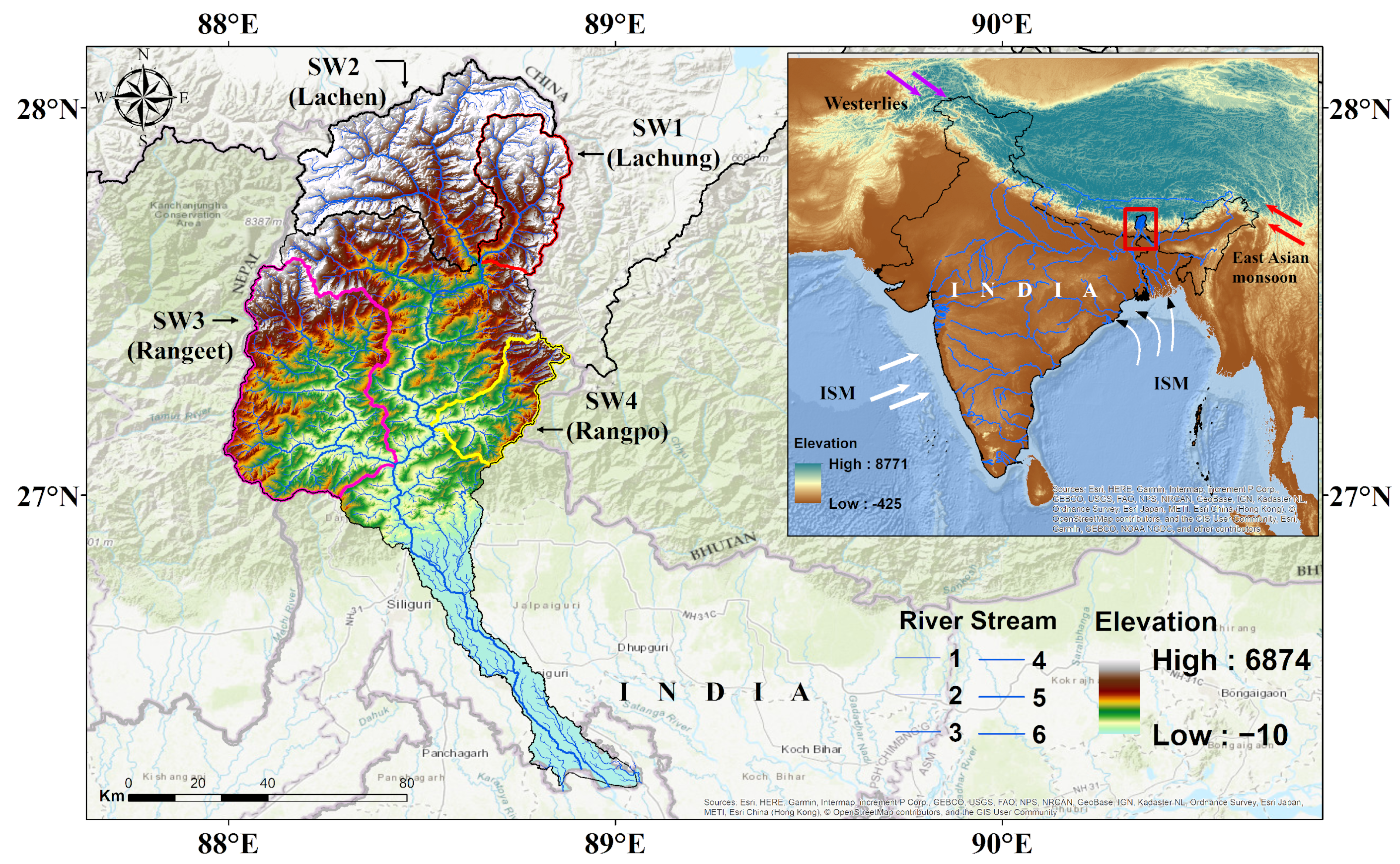
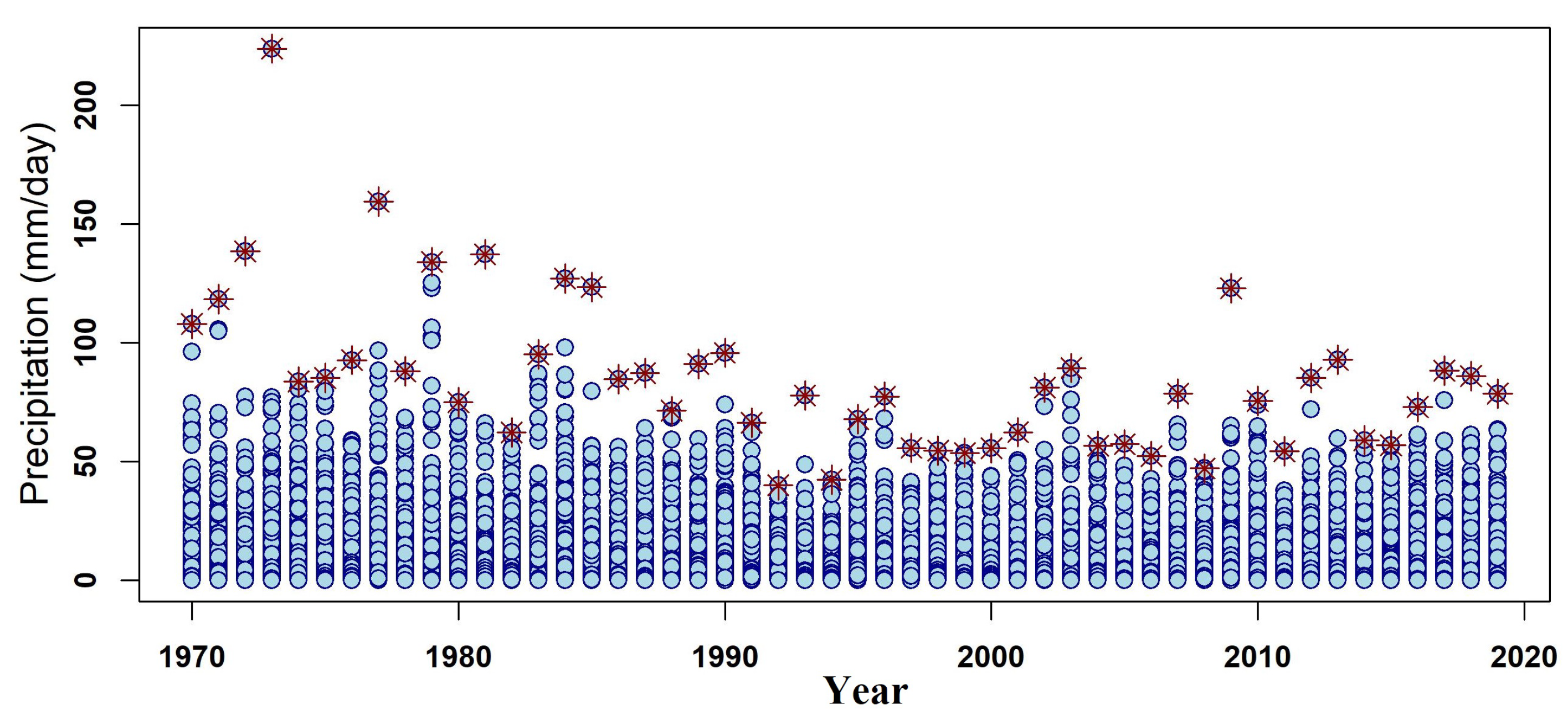

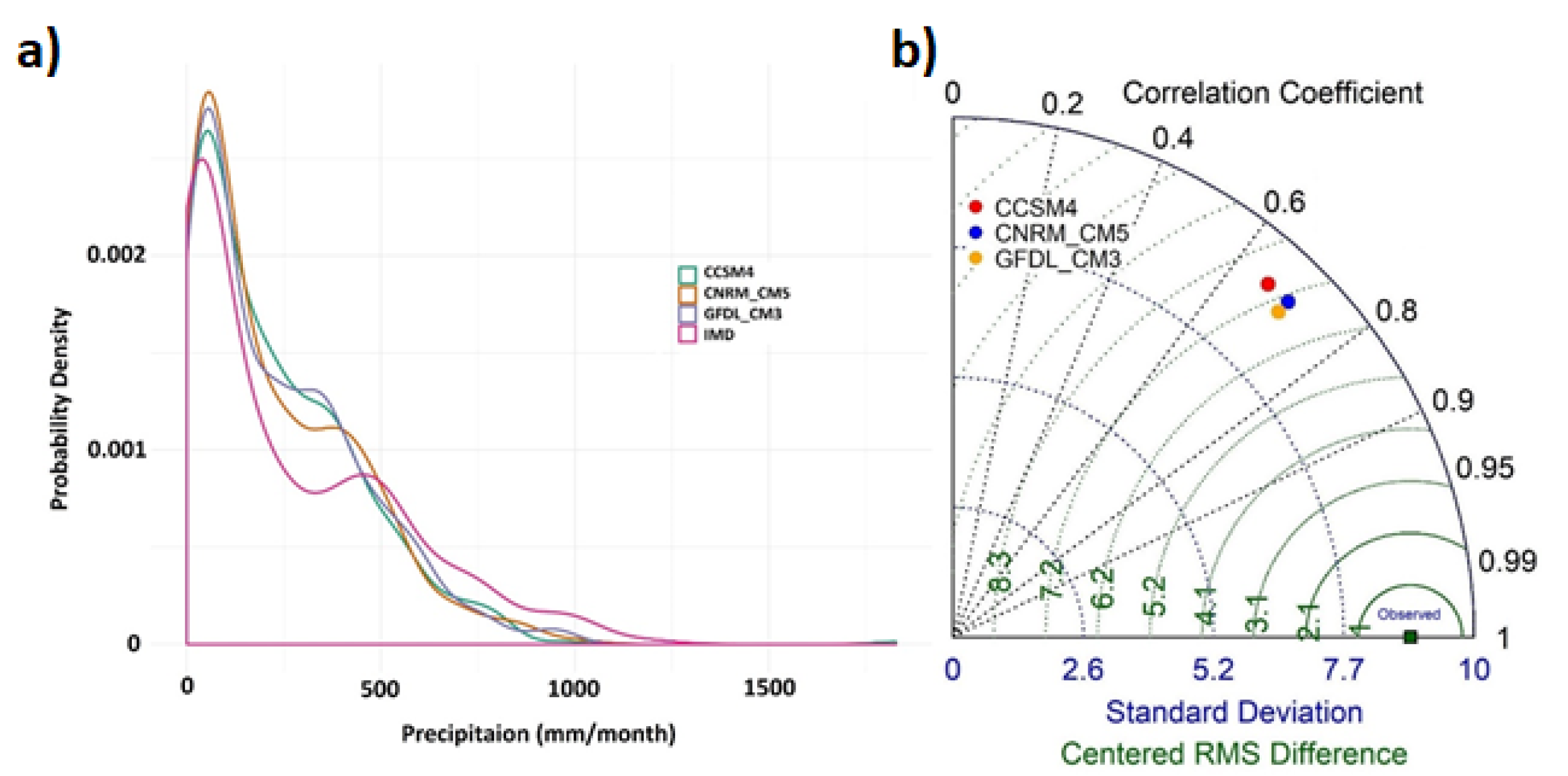
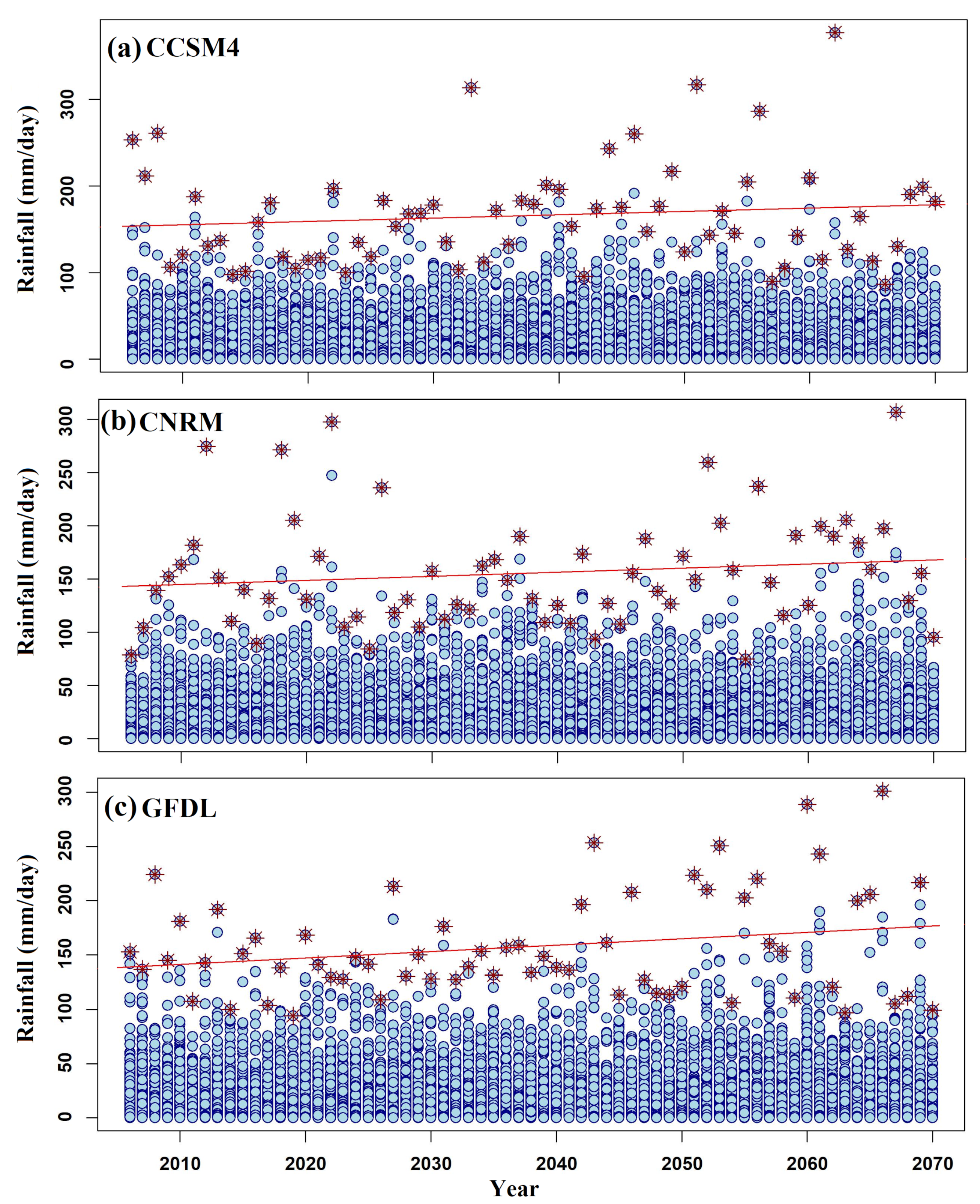
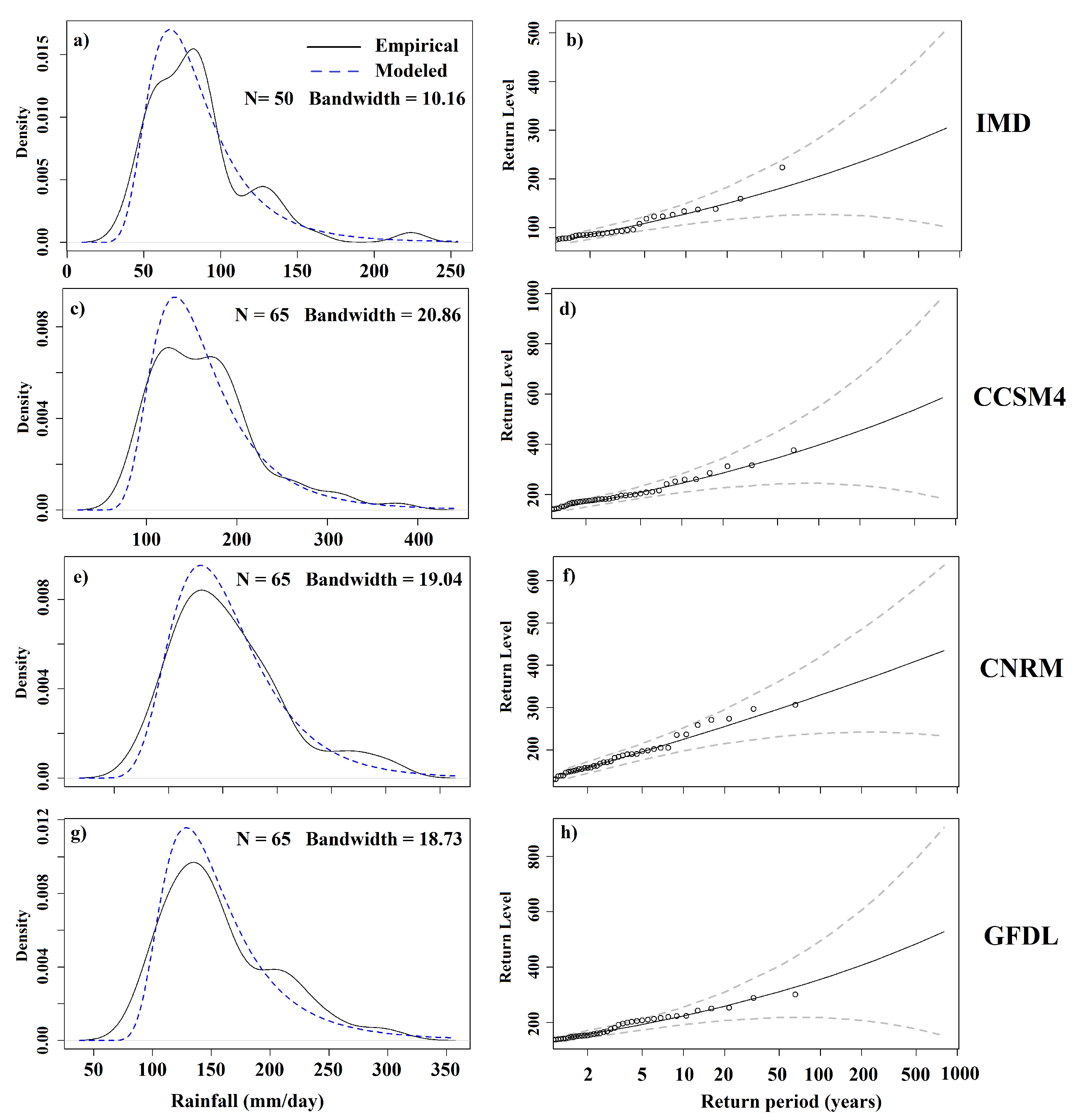
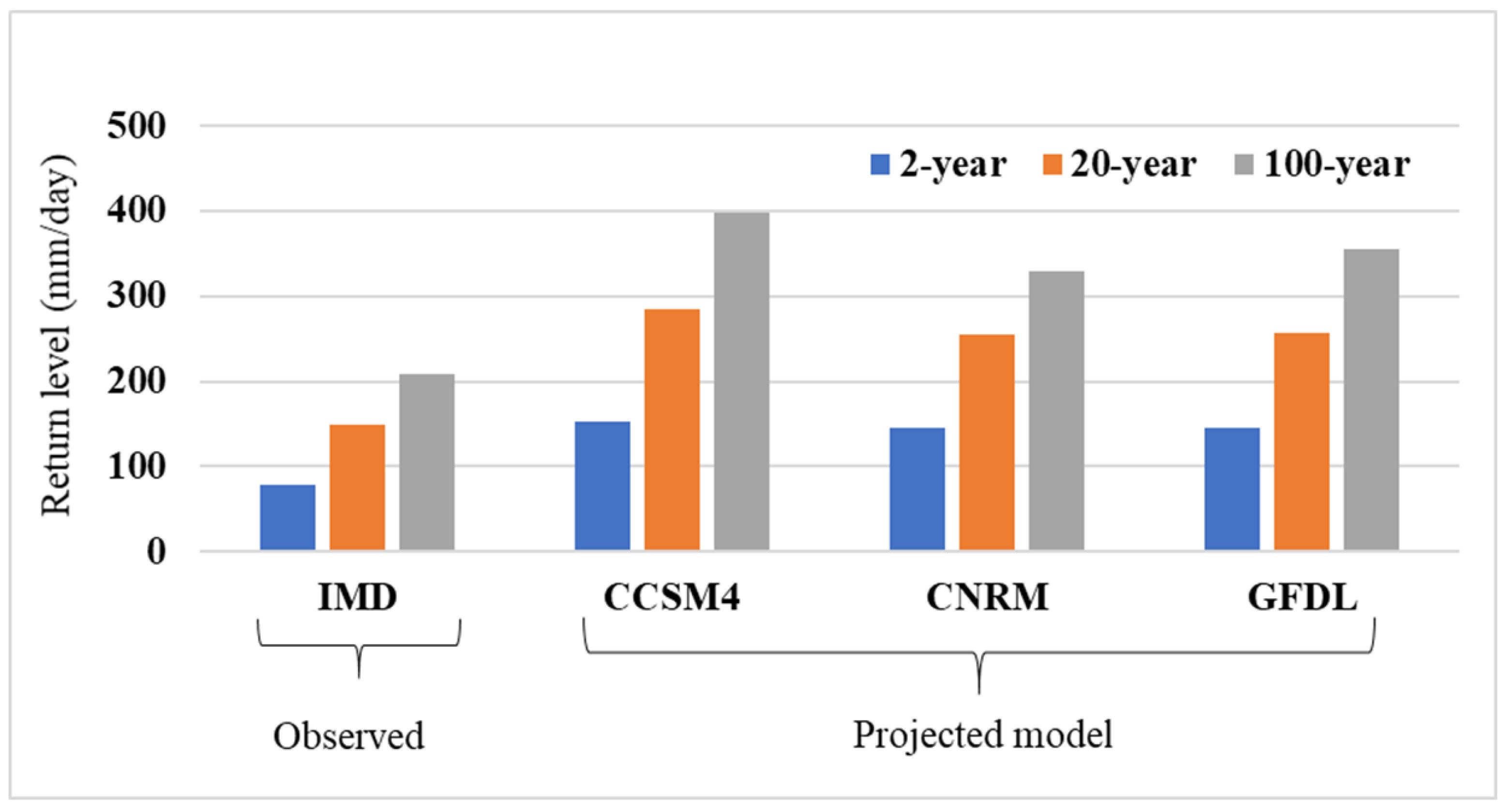
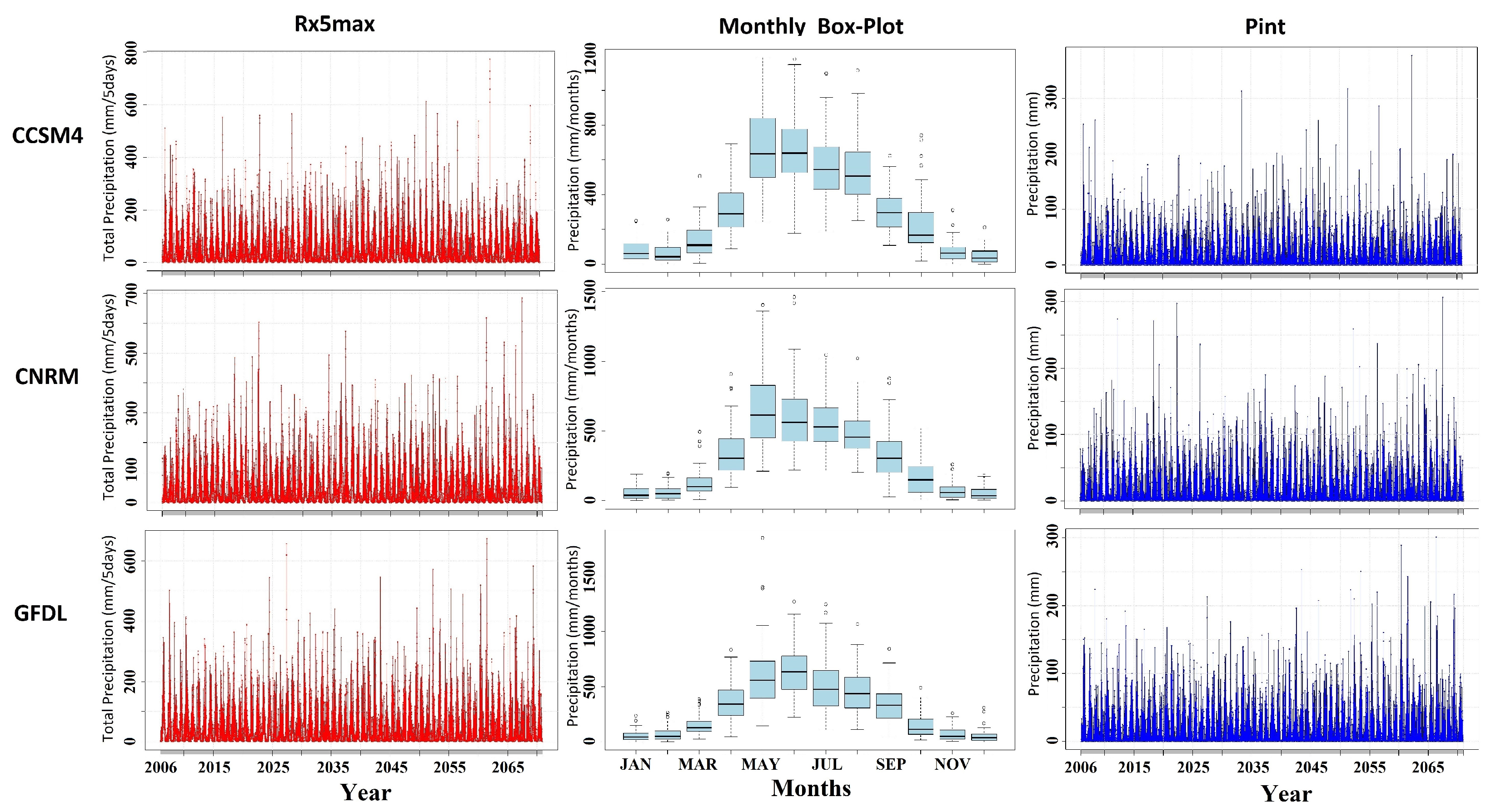
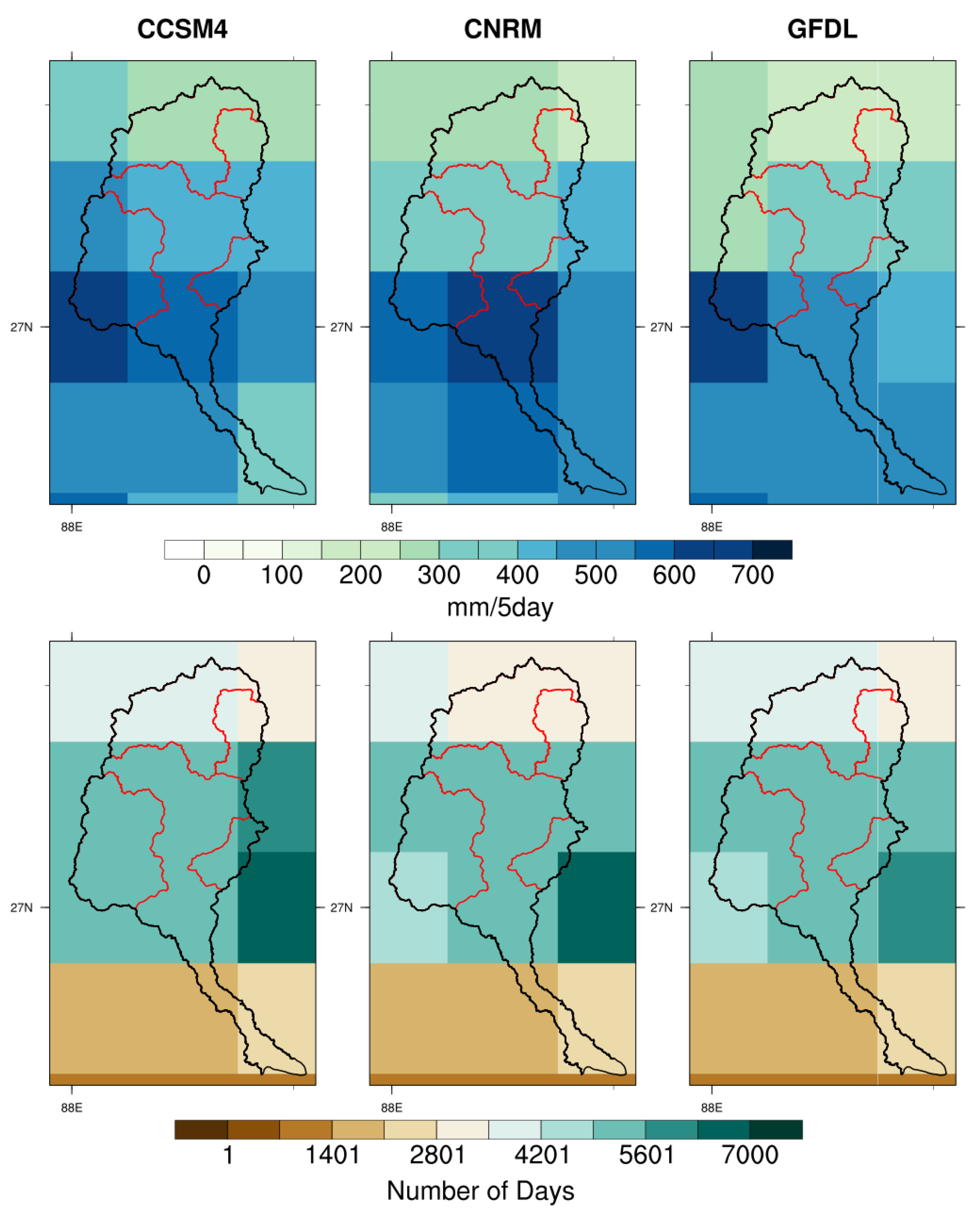
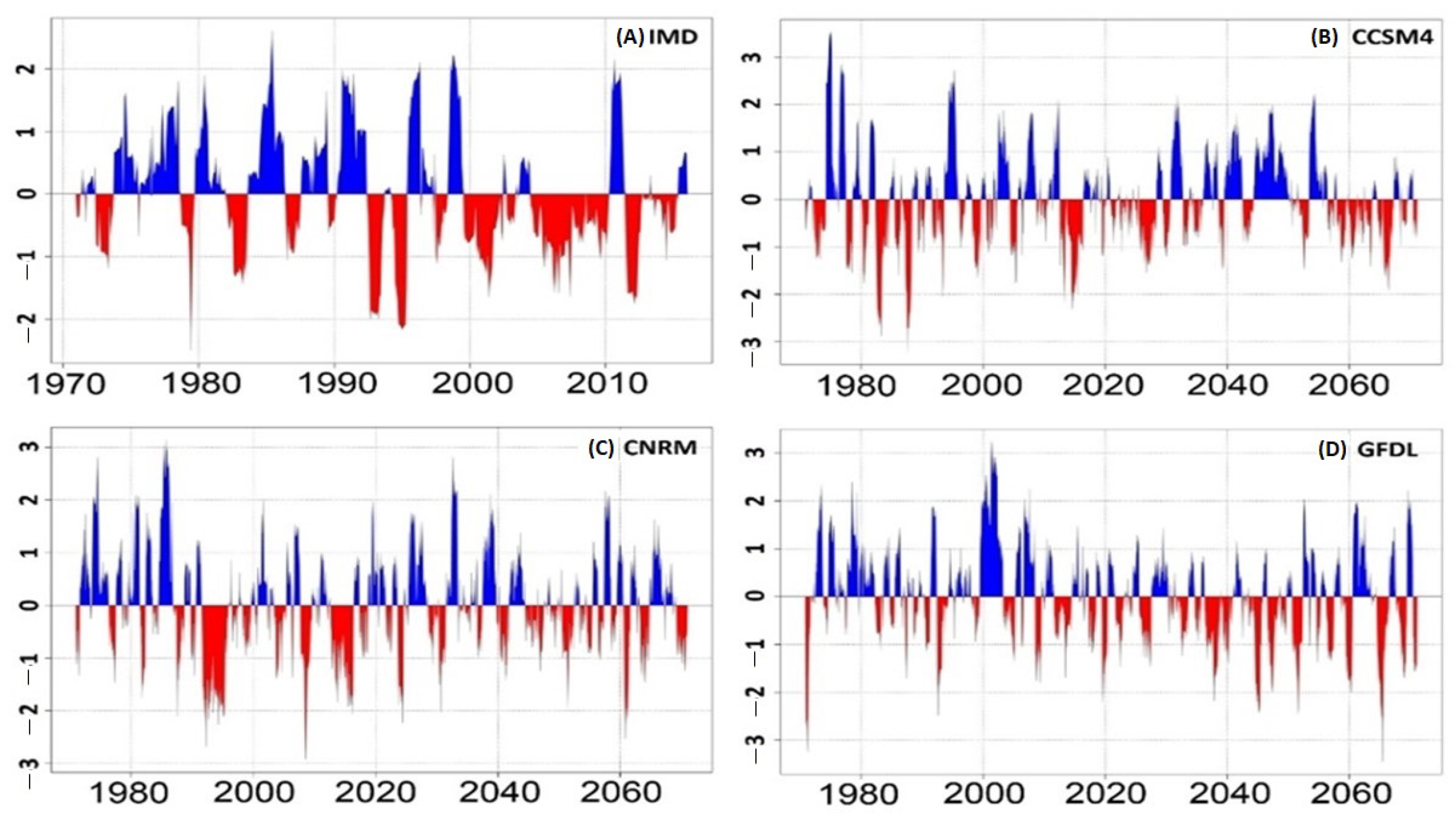
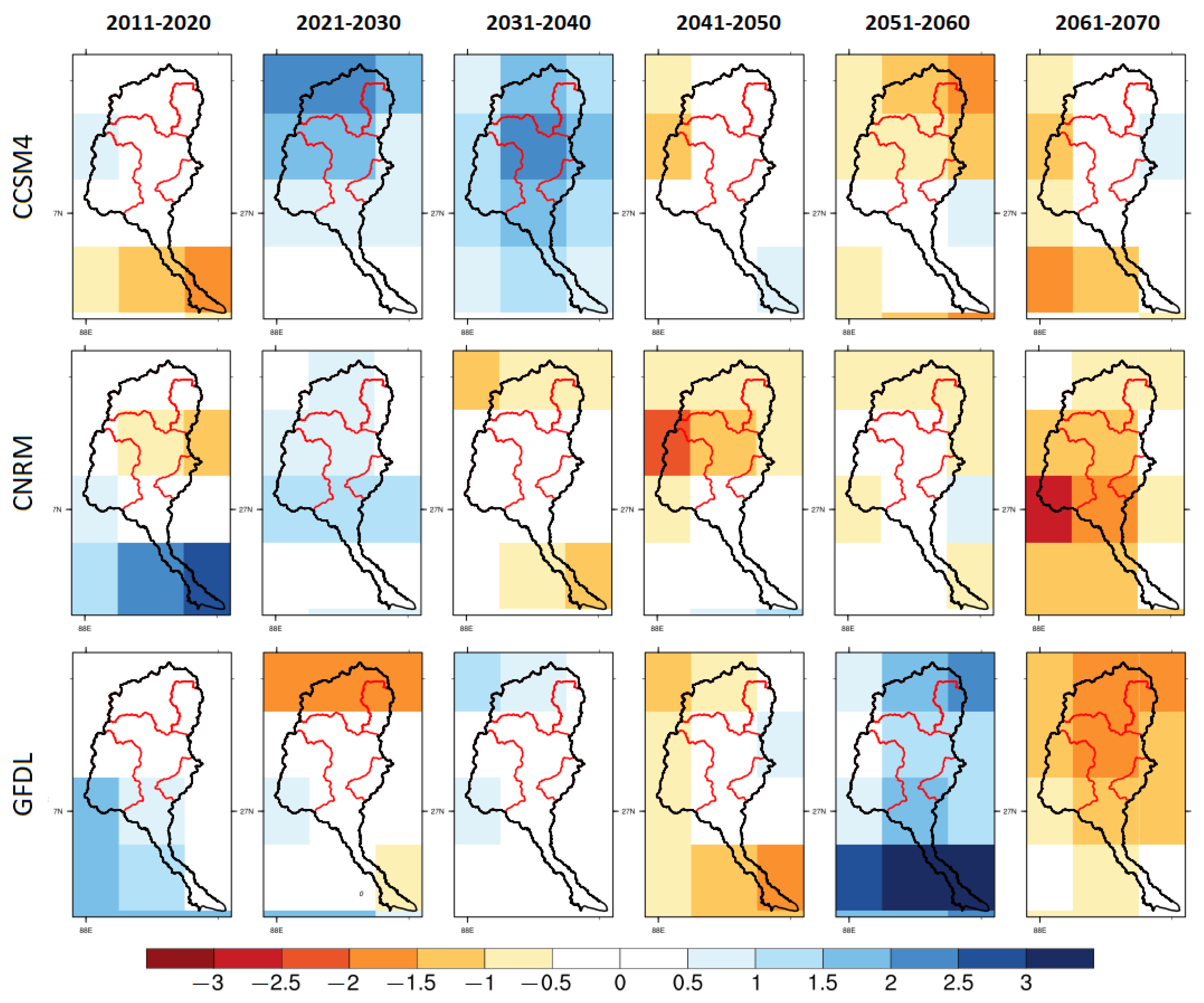
| Morphometric Parameters | MW (Teesta) | SW1 (Lachung) | SW2 (Lachen) | SW3 (Rangeet ) | SW4 (Rangpo) |
|---|---|---|---|---|---|
| Linear | |||||
| Bifurcation ratio (Rb) | 4.35 | 3.51 | 4.07 | 4.22 | 3.12 |
| Rho coefficient (q) | 0.22 | 0.17 | 0.12 | 0.13 | 0.18 |
| Areal aspect | |||||
| Drainage density (Dd) | 0.5 | 0.52 | 0.51 | 0.2 | 0.46 |
| Stream frequency (Fs) | 0.17 | 0.21 | 0.18 | 0.08 | 0.17 |
| Drainage texture (T) | 1.13 | 0.93 | 0.97 | 0.68 | 0.69 |
| Length of overland flow (Lg) | 1 | 0.96 | 0.98 | 2.44 | 1.08 |
| Constant of channel maintenance (C) | 1.99 | 1.92 | 1.96 | 4.89 | 2.16 |
| Form factor (Rf) | 0.05 | 0.22 | 0.25 | 0.58 | 0.23 |
| Circulatory ratio (Rc) | 0.05 | 0.36 | 0.2 | 0.21 | 0.35 |
| Elongation ratio (Re) | 0.25 | 0.53 | 0.57 | 0.86 | 0.54 |
| Relief aspect | |||||
| Basin relief (R) (km) | 6874 | 6514 | 6874 | 5915 | 4612 |
| Relief ratio (Rr) | 14.78 | 86.89 | 61.7 | 63.24 | 88.16 |
| Ruggedness number (Rn) | 3.5 | 2.59 | 2.73 | 1.18 | 2.02 |
| Data Used | Spatial Resolution | Source | Time Period | Data Source |
|---|---|---|---|---|
| DEM | 30 m | SRTM | —— | http://srtm.csi.cgiar.org |
| Observed Gridded Rainfall | 0.25° × 0.25° | IMD | 1970–2018 | http://dsp.imdpune.gov.in/ |
| CCSM4, CNRM-CM5, GFDL-CM3 | 0.5° × 0.5° | CCCR, IITM | 1970–2005 (Historical) 2006–2070 (Projected) | http://cccr.tropmet.res.in |
| SPI (McKee et al. [42]) | Description | RAI (VanRooy [54]) |
|---|---|---|
| ≥ 2.00 | Extremely wet | ≥3.00 |
| 1.50 to 1.99 | Very wet | 2.00 to 2.99 |
| 1.00 to 1.49 | Moderately wet | 1.00 to 1.99 |
| 0.50 to 0.99 | Slightly wet | 0.50 to 0.99 |
| −0.49 to 0.49 | Near normal | −0.49 to 0.49 |
| −0.99 to −0.50 | Slightly dry | −0.99 to −0.50 |
| −1.49 to − 1.00 | Moderately dry | −1.99 to −1.00 |
| −1.99 to −1.50 | Very dry | −2.99 to −2.00 |
| ≤−2.00 | Extremely dry | ≤−3.00 |
| Category | Index | Unit | Definition |
|---|---|---|---|
| Precipitation magnitude | PRwn90 PRwn95 PRwn99 | 90th, 95th and 99th percentile of precipitation on wet days | |
| Rx5max | mm | Greatest 5-day total rainfall per year | |
| Precipitation intensity | Pint | mm/d | Simple daily intensity (rain per rain day ≥ 1 mm) |
| Pnl90 | d | No. of events >long-term 90th percentile | |
| Precipitation persistence | Pn10mm | d | No. of days precipitation ≥10 mm |
| Model | Precipitation on Wet Days at Percentile | Pnl90 | Pn10mm | ||
|---|---|---|---|---|---|
| 90th (PRwn90) | 95th (PRwn95) | 99th (PRwn99) | |||
| CCSM4 | 50.33 | 68.80 | 115.40 | 1243 | 5927 |
| CNRM | 47.72 | 66.40 | 112.36 | 1231 | 5733 |
| GFDL | 48.95 | 68.07 | 119.56 | 1222 | 5513 |
Disclaimer/Publisher’s Note: The statements, opinions and data contained in all publications are solely those of the individual author(s) and contributor(s) and not of MDPI and/or the editor(s). MDPI and/or the editor(s) disclaim responsibility for any injury to people or property resulting from any ideas, methods, instructions or products referred to in the content. |
© 2023 by the authors. Licensee MDPI, Basel, Switzerland. This article is an open access article distributed under the terms and conditions of the Creative Commons Attribution (CC BY) license (https://creativecommons.org/licenses/by/4.0/).
Share and Cite
Chaubey, P.K.; Mall, R.K.; Srivastava, P.K. Changes in Extremes Rainfall Events in Present and Future Climate Scenarios over the Teesta River Basin, India. Sustainability 2023, 15, 4668. https://doi.org/10.3390/su15054668
Chaubey PK, Mall RK, Srivastava PK. Changes in Extremes Rainfall Events in Present and Future Climate Scenarios over the Teesta River Basin, India. Sustainability. 2023; 15(5):4668. https://doi.org/10.3390/su15054668
Chicago/Turabian StyleChaubey, Pawan Kumar, Rajesh Kumar Mall, and Prashant K. Srivastava. 2023. "Changes in Extremes Rainfall Events in Present and Future Climate Scenarios over the Teesta River Basin, India" Sustainability 15, no. 5: 4668. https://doi.org/10.3390/su15054668
APA StyleChaubey, P. K., Mall, R. K., & Srivastava, P. K. (2023). Changes in Extremes Rainfall Events in Present and Future Climate Scenarios over the Teesta River Basin, India. Sustainability, 15(5), 4668. https://doi.org/10.3390/su15054668









